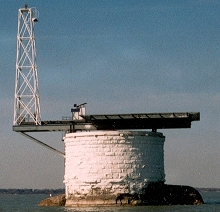 2003 Photograph of the south side of the Colchester Reef Lighthouse in Western Lake Erie. Original structure built in 1885 (white caisson pictured here) and existing helipad and tower were installed / updated in the early 1980s. | |
 | |
| Location | Western Lake Erie, Approx 4 Nautical Miles South of Colchester, Ontario, Canada |
|---|---|
| Coordinates | 41°55′55.9″N82°53′27.6″W / 41.932194°N 82.891000°W (current) |
| Tower | |
| Constructed | 1885 (first) |
| Foundation | stone caisson |
| Construction | steel skeleton tower on cylindrical caisson |
| Automated | 1936 |
| Height | 12 metres (39 ft) |
| Shape | cylindrical stone caisson basement with white skeleton tower and helipad |
| Markings | white / grey |
| Operator | Canadian Coast Guard |
| Light | |
| Focal height | 21.6 metres (71 ft) |
| Range | 5 nautical miles (9.3 km; 5.8 mi) |
| Characteristic | Fl R 4s. |
The Colchester Reef Light is an active lighthouse situated on Colchester Reef in the Western Basin of Lake Erie south of the town of Colchester, Ontario. [1]
Contents
It was originally built in 1885 by Colonel William P. Anderson to replace a lightvessel that was previously stationed on that location. The original lighthouse tower was demolished in 1954 and the current structure is a white steel skeletal tower with a helicopter landing pad.
It is currently listed on the Canadian List of Lights as Light No. 620 and can be found on the Canadian Hydrographic Service Chart No. 2123. [2]